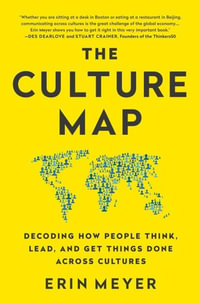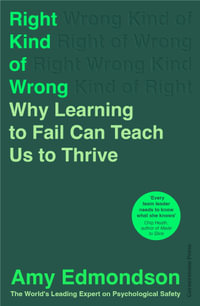
Six Thinking Hats : Popular Penguins
By: Edward de Bono
Paperback | 1 September 2008 | Edition Number 1
At a Glance
192 Pages
1.2 x 11.2 x 18
Paperback
$14.99
or 4 interest-free payments of $3.75 with
About The Author
Edward de Bono has had faculty appointments at the universities of Oxford, London, Cambridge and Harvard. He is widely regarded as the leading authority in the direct teaching of thinking as a skill. He originated the concept of lateral thinking and developed formal techniques for deliberate creative thinking. He has written sixty-two books, which have been translated into thirty-seven languages, has made two television series and there are over 4,000,000 references to his work on the Internet.
Dr de Bono has been invited to lecture in fifty-two countries and to address major international conferences. In 1989 he was asked to chair a special meeting of Nobel Prize laureates. His instruction in thinking has been sought by some of the leading business corporations in the world such as IBM, DuPont, Shell, Ericsson, McKinsey, Ciba-Geigy, Ford and many others. He has had a planet named after him by the International Astronomic Union and was named by a group of university professors in South Africa as one of the 250 people in all history who have contributed most to humanity.
Dr de Bono runs the most widely used programme for the direct teaching of thinking is schools. This is now in use in many countries around the world.
Dr de Bono's key contribution has been his understanding of the brain as a self-organizing system. From this solid base he set out to design practical tools for thinking. His work is in use equally in the boardrooms of some of the world's largest corporations and with four-year-olds in school. His design of the Six Hats method provides, for the first time, Western thinking with a constructive idiom instead of adversarial argument. His work is in use in elite gifted schools, rural schools in South Africa and Khmer villages in Cambodia. The appeal of Dr de Bono's work is its simplicity and practicality.
For more information about Dr de Bono's public seminars, private seminars, certified training programmes, thinking programmes for schools, CD Rom, books and tapes, please contact: Diane McQuaig, The McQuaig Group, 132 Rochester Avenue, Toronto M4N 1P1, Ontario, Canada. Tel: (416) 488 0008. Fax: (416) 488 4544.
That may seem a rather exaggerated claim but the evidence is beginning to point that way. When this book was first published fourteen years ago, such a claim would have been nonsense. But over the years, the evidence to support it has been steadily accumulating.
A major corporation (ABB) used to spend thirty days on their multinational project team discussions. Using the parallel thinking of the Six Hats method, the discussions now take as little as two days. A researcher from a top IBM laboratory told me that the Six Hats method had reduced meeting times to one quarter of what they had been. Statoil in Norway had a problem with an oil rig that was costing about one hundred thousand dollars a day. A certified trainer, Jens Amp, introduced the Six Hats method and in twelve minutes the problem was solved – and the one-hundred-thousand-dollar-a-day expenditure was reduced to nil. There were two similar law cases: in one case the jury took more than three hours to reach a decision. In the second case, one juror introduced the Six Hats method. A decision was reached in fifteen minutes. In a simple experiment with three hundred senior civil servants, the introduction of the Six Hats method increased thinking productivity by 493 per cent.
Those examples show huge changes. We are normally very happy with productivity increases of 5 or 10 per cent. Here we have changes of 500 per cent and more. Something is happening.
Widespread Use Around the World
I can report that the Six Hats method is now very widely used around the world. When I first designed the concept I had no idea how rapid the spread would be. The method is simple, robust and effective – which accounts for the very widespread use.
Last year I received two letters on the same day. One letter was from the head of research at Siemens in Germany. Siemens is by far the largest corporation in Europe with close to four hundred thousand employees and a turnover in excess of sixty billion dollars. They now have thirty-seven internal trainers in my methods and every department has a special 'innovation unit' based on my methods. In his letter, the head of research told how he had used the Six Hats method with success at a senior research meeting. The second letter was from Simon Batchelor, who had been on an aid mission to Cambodia to help the Khmer villagers drill for water. He found it difficult to get the villagers involved in the process. He had my book Teach Your Child How to Think with him and, from this book, he taught the Six Hats method to the Khmer villagers. They became so enthusiastic that they told him that learning to think was more important than drilling for water.
A few days later I was in Wellington, New Zealand, and the head teacher of Wellesley School (a leading school in New Zealand) told me that he was teaching the method to five-year-olds. (A few months later, the head teacher of Clayfield College in Brisbane told me that they even taught it to four-year-olds.) A week after being in New Zealand I spoke at a major Microsoft marketing meeting in Seattle and introduced the attendees to the parallel thinking of the Six Hats method. The method has been used by NASA, IBM, DuPont, NTT (Japan), Shell, BP, Statoil (Norway), Marzotto (Italy), and Federal Express, among many others. This shows the remarkable adaptability of the Six Hats method: it can be taught with equal success to top-level executives and to pre-school children.
The Six Hats Method
Thinking is the ultimate human resource. Yet we can never be satisfied with our most important skill. No matter how good we become, we should always want to be better. Usually, the only people who are very satisfied with their thinking skill are those poor thinkers who believe that the purpose of thinking is to prove yourself right – to your own satisfaction. If we have only a limited view of what thinking can do, we may be smug about our excellence in this area, but not otherwise.
The main difficulty of thinking is confusion. We try to do too much at once. Emotions, information, logic, hope and creativity all crowd in on us. It is like juggling with too many balls.
What I am putting forward in this book is a very simple concept which allows a thinker to do one thing at a time. He or she becomes able to separate emotion from logic, creativity from information, and so on. The concept is that of the six thinking hats. Putting on anyone of these hats defines a certain type of thinking. In the book I describe the nature and contribution of each type of thinking.
The six thinking hats allow us to conduct our thinking as a conductor might lead an orchestra. We can call forth what we will. Similarly, in any meeting it is very useful to switch people out of their usual track in order to get them to think differently about the matter in hand.
It is the sheer convenience of the six thinking hats that is the main value of the concept.
Special Note on the Black Hat
I am writing this special note because a few people have misinterpreted the black hat and have somehow regarded it as a bad hat. On the contrary, the black hat is the most valuable of all the hats and certainly the most used. Using the black hat means being careful and cautious. The black hat points out difficulties, dangers and potential problems. With the black hat you avoid danger to yourself, to others and to the community. It is under the black hat that you point out possible dangers.
For the most part, the thrust of Western thinking has been the 'black hat' with an emphasis on critical thinking and caution. It prevents mistakes, excesses and nonsenses.
Notes on the New Edition
Today, there is a huge amount of experience using the Six Hats method. This was not the case when I first wrote the book. The method can therefore be introduced with confidence. It is no longer a matter of trying out something new and exotic. It is now a matter of catching up with a powerful thinking method that has been in use for fourteen years across all ages, cultures and abilities.
People are sometimes hesitant about the hats and colours because they do not seem serious or complicated enough (some people love complexity). In practice, the simplicity has never been a problem. People realize they need the hats and colours as simple mental hooks. Hats and colours are much easier to remember than are complicated psychological terms.
This revised and updated edition is based on my experience using and working with the Six Hats method. Over the years it has become apparent that the method is both powerful and easy to use. The effectiveness of the method is much greater than I had ever imagined. It is an alternative to the argument system, which was never intended to be constructive or creative. With the Six Hats method the emphasis is on 'what can be' rather than just on 'what is', and on how we design a way forward – not on who is right and who is wrong.
ISBN: 9780141037554
ISBN-10: 0141037555
Series: Popular Penguins
Published: 1st September 2008
Format: Paperback
Language: English
Number of Pages: 192
Audience: General Adult
Publisher: Penguin UK
Country of Publication: GB
Edition Number: 1
Dimensions (cm): 1.2 x 11.2 x 18
Weight (kg): 0.11
Shipping
| Standard Shipping | Express Shipping | |
|---|---|---|
| Metro postcodes: | $9.99 | $14.95 |
| Regional postcodes: | $9.99 | $14.95 |
| Rural postcodes: | $9.99 | $14.95 |
How to return your order
At Booktopia, we offer hassle-free returns in accordance with our returns policy. If you wish to return an item, please get in touch with Booktopia Customer Care.
Additional postage charges may be applicable.
Defective items
If there is a problem with any of the items received for your order then the Booktopia Customer Care team is ready to assist you.
For more info please visit our Help Centre.
You Can Find This Book In

The Fearless Organization
Creating Psychological Safety in the Workplace for Learning, Innovation, and Growth
Hardcover
RRP $52.95
$39.35
OFF
This product is categorised by
- Non-FictionPsychologyCognition & Cognitive Psychology
- FictionPopular Penguins
- Non-FictionBusiness & Management
- Non-FictionReference, Information & Interdisciplinary SubjectsResearch & InformationDecision Theory
- Non-FictionSelf-Help, Personal Development & Practical AdvicePopular PsychologyMemory Improvement & Thinking Techniques
- Non-FictionPsychologyOccupational & Industrial Psychology






















